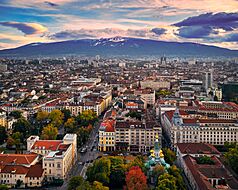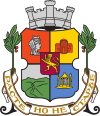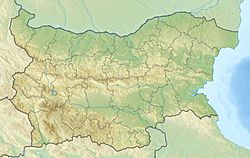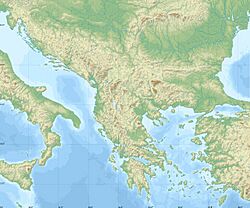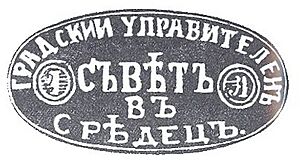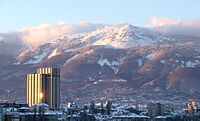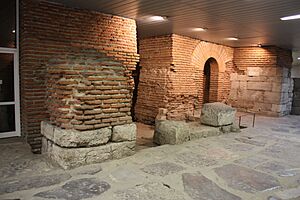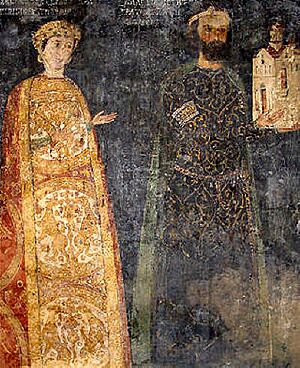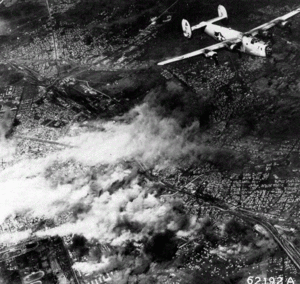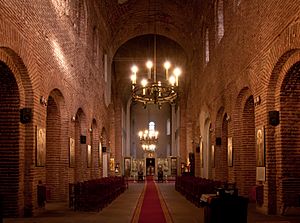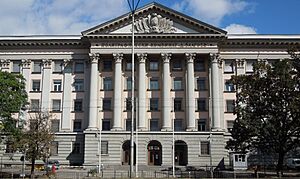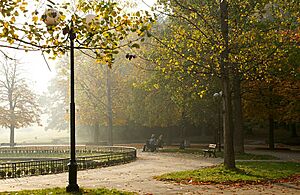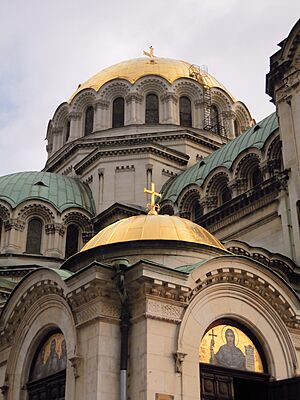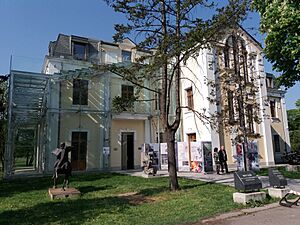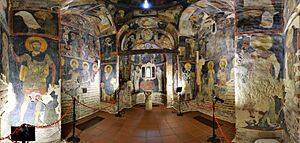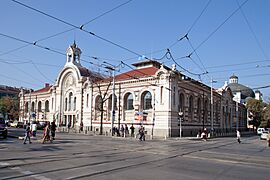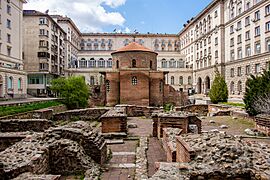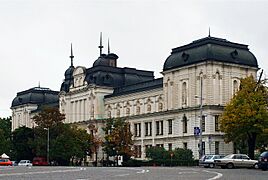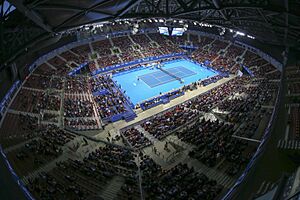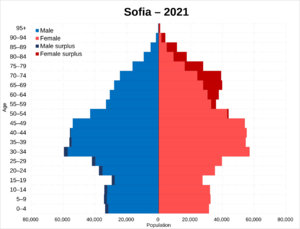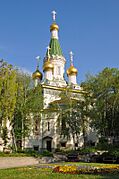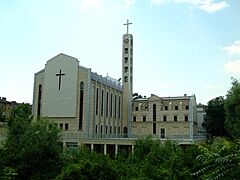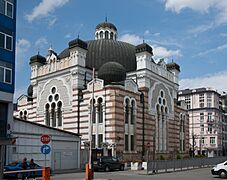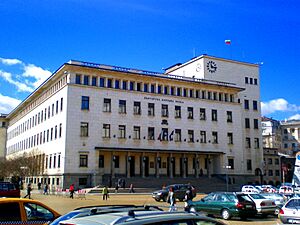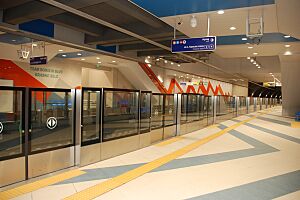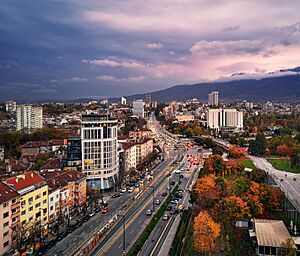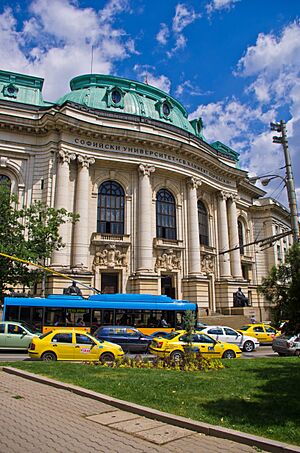Sofia facts for kids
Quick facts for kids
Sofia
София
|
|||
|---|---|---|---|
|
Panoramic view over central Sofia and the Vitosha Mountain
Ivan Vazov National Theatre
Banya Bashi Mosque
Sofia Central Mineral Baths
Church of Saint George
Statue of Sveta Sofia
|
|||
|
|||
| Motto(s):
"Ever growing, never aging"
("Расте, но не старее") |
|||
| Country | Bulgaria | ||
| Province | Sofia City | ||
| Municipality | Capital | ||
| Cont. inhabited | since 7000 BC | ||
| Neolithic settlement | 5500–6000 BC | ||
| Thracian settlement | 1400 BC | ||
| Roman administration | 46 AD (as Serdica) | ||
| Conquered by Krum | 809 AD (as Sredets) | ||
| Area | |||
| • Capital city | 500 km2 (200 sq mi) | ||
| • Urban | 5,723 km2 (2,210 sq mi) | ||
| • Metro | 10,738 km2 (4,146 sq mi) | ||
| Elevation | 500–699 m (1,640–2,293 ft) | ||
| Population
(2024)
|
|||
| • Capital city | 1,286,965 | ||
| • Density | 2,570/km2 (6,700/sq mi) | ||
| • Urban | 1,547,779 | ||
| • Urban density | 270.449/km2 (700.46/sq mi) | ||
| • Metro | 1,667,314 | ||
| • Metro density | 155.272/km2 (402.153/sq mi) | ||
| Demonym(s) | Sofian (en) Софиянец/Sofiyanets (bg) |
||
| Time zone | UTC+2 (EET) | ||
| • Summer (DST) | UTC+3 (EEST) | ||
| Area code(s) | (+359) 02 | ||
| GDP per capita (2021) | 45241.00 BGN |
||
| HDI (2018) | 0.945 very high |
||
| Vehicle registration plate | C, CA, CB | ||
Sofia is the capital and largest city of Bulgaria. It is located in the Sofia Valley, at the foot of the Vitosha mountain. This city is in the western part of the country. Sofia is built west of the Iskar River and has many natural mineral springs. It has a humid continental climate, meaning it has warm summers and cold winters. Sofia is in the center of the Balkans, between the Black Sea and the Adriatic Sea. It is also close to the Aegean Sea.
Sofia has been a place where people lived for a very long time, since at least 7000 BC. In ancient times, it was known as Serdica. Later, in the Middle Ages, it was called Sredets. The city became part of the First Bulgarian Empire in 809 AD. It was then taken over by the Byzantine Empire in 1018. However, it returned to the Second Bulgarian Empire in 1194. The Ottoman Empire conquered Sofia in 1382. Bulgarian rule was restored in 1878. Sofia was chosen as the capital of the new Bulgarian state in 1879. This led to a lot of growth for the city.
Sofia is the 14th-largest city in the European Union. It is surrounded by mountains like Vitosha, Lyulin, and the Balkan Mountains. This makes it the third highest capital city in Europe. As Bulgaria's main city, Sofia is home to many important universities, cultural places, and businesses. It is known as the "triangle of religious tolerance." This is because three major religious buildings are close together: Sveta Nedelya Church (Christian), Banya Bashi Mosque (Islam), and Sofia Synagogue (Judaism). The Catholic Cathedral of St Joseph also makes it a "square" of tolerance.
Sofia is considered one of the best places for new businesses, especially in technology. It was also Europe's most affordable capital to visit in 2013. The Boyana Church in Sofia is a World Heritage Site. It is important for its history and beautiful paintings. Sofia is also home to the National Opera and Ballet of Bulgaria, the National Palace of Culture, and the Ivan Vazov National Theatre.
Contents
- City Names Through History
- Geography and Environment
- History of Sofia
- Cityscape and Architecture
- Culture and Attractions
- Sports in Sofia
- Population and Demographics
- Economy and Business
- Transportation and Infrastructure
- Education and Science
- International Connections
- Honors
- Media in Sofia
- Images for kids
- See also
City Names Through History
For a long time, Sofia was called Serdica. This name came from a tribe called the Serdi. The Roman Emperor Trajan gave the city the name Ulpia Serdica. Other old names for Sofia include Serdonpolis and Triaditza.
The Slavic name Sredets means "middle". It first appeared in writing in the 11th century. The city was also called Atralisa or Strelisa by travelers.
The name Sofia comes from the Saint Sofia Church. The word "Sofia" means "wisdom" in Greek. This name started appearing in documents around the 1300s. Even then, people from the area were still called "Sredecheski." When the Ottomans ruled, they called the city Sofya. In 1879, there was a discussion about what the new capital's name should be. People decided to use Sofia for national things and Sredets for local government, but eventually, Sredets was no longer used.
Geography and Environment
Sofia City Province covers an area of 1344 square kilometers. Sofia's location in the middle of the Balkans helped it grow into an important city. It is in western Bulgaria, at the northern base of the Vitosha mountain. The Balkan Mountains are to the north. The valley where Sofia sits is about 550 meters (1,800 feet) above sea level. Sofia is the second highest capital in the European Union.
Several small rivers flow through the city, like the Boyanska and Perlovska. The Iskar River flows near eastern Sofia. It starts in Rila, Bulgaria's highest mountain. The Iskar flows north through the Sofia Valley and then through the beautiful Iskar Gorge.
The city is also known for its 49 mineral springs and hot springs. Many artificial lakes and dams were built in the 20th century.
Climate and Weather
Sofia has a humid continental climate. This means it has cold, snowy winters and warm, sunny summers. The average temperature for the year is about 10.9°C (51.6°F).
In winter, temperatures can drop below -15°C (5°F). The lowest temperature ever recorded was -31.2°C (-24.2°F) in 1893. Sofia usually gets about 98 cm (38.6 inches) of snow each winter.
Summers are warm. Sofia is a bit cooler than other parts of Bulgaria because it is higher up. But heat waves can still happen, with temperatures reaching over 35°C (95°F). The highest temperature ever recorded was 40.2°C (104.4°F) in 2000.
Spring and autumn are usually short with changing weather. The city gets about 625.7 mm (24.6 inches) of rain each year. Most rain falls in late spring and early summer, often with thunderstorms.
Air Quality and Environment
Sofia's valley location can trap air pollution. This means the air can sometimes be unhealthy. Pollution comes from burning solid fuels for heating and from cars. Smog can stay over the city because the mountains stop air from moving. This makes Sofia's air pollution levels some of the highest in Europe.
Tiny particles in the air are often above safe levels. In response, the city has tried different things, like washing streets more often. However, there are still challenges to making the air cleaner.
History of Sofia
Sofia's history goes back almost 7,000 years. People were drawn to the area because of its hot water springs. The oldest known village was in Slatina, dating back to 5000-6000 BC.
The Thracian tribe called the Tilataei were among the first to settle here. Later, the Celtic tribe Serdi gave the city its first name, Serdica. The Romans conquered Serdica in 29 BC. It grew into an important Roman city with walls, public baths, and an amphitheatre. Serdica was a key city on the Roman road connecting important places.
Roman emperors Aurelian and Galerius were born in Serdica. In 311 AD, Emperor Galerius issued the Edict of Toleration by Galerius in Serdica. This was the first official step to make Christianity legal in the Roman Empire. Emperor Constantine the Great even thought about making Serdica the capital of his empire instead of Constantinople.
The city was destroyed by the Huns in 447 AD. It was rebuilt by the Byzantine Emperor Justinian I.
Sofia in the Middle Ages
Serdica became part of the First Bulgarian Empire in 809 AD, after a long siege. The city was then known by its Slavic name, Sredets. It became an important fortress and center. The Bulgarian patron saint John of Rila was buried here. Sredets was even the temporary capital of Bulgaria in the late 10th century.
The city fell to the Byzantine Empire in 1018. But it was brought back into the Second Bulgarian Empire in 1194. Sredets became a major center for administration and culture. Many monasteries were built nearby, but they were later destroyed by the Ottomans.
In 1382, Sredets was taken by the Ottoman Empire after a three-month siege.
Sofia Under Ottoman Rule
From the 14th to the 19th century, Sofia was a very important center in the Ottoman Empire. It became the capital of Rumelia Eyalet, which was the main Ottoman province in Europe. Sofia was also a big trading hub.
During the 15th and 16th centuries, the Ottomans built many new buildings in Sofia. The city became very diverse with Muslims, Christians, Armenians, Jews, and Romani people living there. Many churches, like Saint Sofia and Saint George, were turned into mosques. New mosques were also built, including the Banya Bashi Mosque.
Sofia's importance declined in the 17th century. By the 19th century, the Bulgarian people in Sofia started to work for their national revival. They opened schools and cultural centers. In 1873, the Bulgarian revolutionary Vasil Levski was captured and executed in Sofia by the Ottomans.
Modern Sofia
Sofia was freed from Ottoman rule by Russian forces on January 4, 1878. It was chosen as the capital of the new Bulgarian state in 1879. At that time, only about 11,649 people lived there.
After its liberation, Sofia grew very quickly. Many people moved there from other parts of Bulgaria. In the Second Balkan War in 1913, Sofia was the first capital city to be flown over by enemy aircraft.
During World War II, Sofia was bombed by US and UK air forces in 1943 and 1944. Many buildings were destroyed. In 1944, the Soviet Red Army occupied Sofia. After the war, Bulgaria became a communist country. Sofia's population grew even more, and new neighborhoods were built.
After communism ended in 1989, Sofia changed a lot. Many old street names were brought back. The city continued to grow and develop.
Cityscape and Architecture

Sofia has many different types of buildings. You can see ancient Roman ruins, medieval Bulgarian fortresses, and newer styles. These include Neoclassicism and modern glass buildings.
After Bulgaria gained independence, architects from Austria-Hungary helped design the new capital. They built important public buildings and homes in styles like Neo-Baroque and Neo-Renaissance.
After World War II, when a communist government was in charge, the architecture changed. Large government buildings were built in a style called Stalinist Gothic. New neighborhoods had many concrete apartment blocks.
Since 1989, Sofia has seen new business districts and modern office buildings. The Capital Fort Business Centre is the first skyscraper in Bulgaria. However, there has also been a lot of unplanned building.
Green Spaces and Parks
Sofia has many green areas and parks. The main parks are Borisova gradina in the city center, and the Southern, Western, and Northern parks. There are also smaller parks like Vazrazhdane Park and City Garden.
The Vitosha Nature Park is the oldest national park in the Balkans. It covers a large part of Vitosha mountain, and about half of it is within Sofia's city limits. Vitosha is a popular place for hiking. In winter, you can ski there.
Culture and Attractions
Sofia is a center for arts and entertainment in Bulgaria. Theater is very popular. The Ivan Vazov National Theatre is the most famous theater. The National Opera and Ballet of Bulgaria has been performing since 1909. Many famous opera singers started their careers there.
Movies are also very popular. Many modern cinemas are in shopping centers. The Nu Boyana Film Studios are used to film many action movies.
Museums and Galleries
Sofia has Bulgaria's largest art museums. The National Art Gallery is in the former royal palace. It has a huge collection of art from different cultures and times. The crypt of the Alexander Nevsky cathedral also has a collection of old Eastern Orthodox icons.
The National History Museum has over 650,000 historical items. These items range from ancient times to today. The National Archaeological Museum is in a former mosque. It displays historical items too. Other museums include the Natural History Museum, the Ethnographic Museum, and the Military History Museum.
The SS. Cyril and Methodius National Library is the country's main library. It holds millions of books and documents.
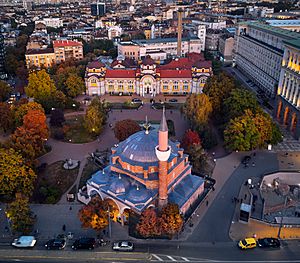
The Boyana Church is a UNESCO World Heritage site. It has amazing frescoes (wall paintings) from the 13th century. These paintings show more than 240 people and 89 scenes. They are very realistic and important for art history.
Popular Tourist Spots
Sofia is a popular place for tourists. The Alexander Nevsky Cathedral is one of Bulgaria's most famous symbols. It was built in the late 19th century and can hold 10,000 people.
In the city center, you can see many remains of ancient Serdica. These include old city walls, Roman baths, and the 4th-century Rotunda of St. George.
Vitosha Boulevard, also called Vitoshka, is a street just for walking. It has many cafes, restaurants, and shops. Sofia's location near the Vitosha mountain also adds to its special feel.
- Some of tourist attraction in Sofia
Sports in Sofia
Sofia has many sports clubs. During the communist era, clubs like CSKA and Levski were strong in many sports, not just football. Basketball and volleyball are also very popular. The Bulgarian Volleyball Federation is one of the oldest in the world.
Sofia tried to host the Winter Olympic Games in 1992, 1994, and 2014. The city has hosted other big sports events, like the 1957 EuroBasket and the Universiade (a sports event for university students). In 2012, it hosted the FIVB World League finals for volleyball.
The city has several large sports venues. The Vasil Levski National Stadium can hold 43,000 people and hosts international football matches. Arena Sofia is a large indoor arena that can hold up to 19,000 people. There are also two ice skating complexes.
Tennis is becoming more popular. There are many tennis courts in the city. Sofia was named the European Capital of Sport in 2018. This was because it promotes sports for everyone.
Population and Demographics
In 2018, Sofia had about 1.4 million residents. The entire Sofia Capital Municipality had about 1.5 million people. The first count in 1878 found 11,694 people living in Sofia. Most were Bulgarians, but there were also Jews, Turks, and Romani people.
Sofia's population has grown a lot because many people move there from other parts of Bulgaria. In 2011, the largest age group was people aged 20–24. Most citizens are Eastern Orthodox Christians. Many people in Sofia have a university degree.
Most people in Sofia work in trading or manufacturing. Most homes have access to television and the internet. Over 99.6% of people over 9 years old can read and write. Many families in Sofia have two or three people.
Sofia became the capital in 1879. In 1880, it was the fifth-largest city in Bulgaria. By 1892, Sofia became the most populated city. Today, about 17% of Bulgaria's population lives in Sofia.
- Religious buildings in Sofia
Economy and Business
Sofia is a very important economic center for Bulgaria. Many major Bulgarian and international companies have their main offices here. The Bulgarian National Bank and the Bulgarian Stock Exchange are also in Sofia.
In 2015, Sofia was ranked among the top cities for growth in jobs and economy in Southeast Europe. Forbes magazine listed Sofia as one of the top 10 places in the world to start a new business. This is because of low taxes, fast internet, and available investment funds.
The city's economy is mostly based on services. However, manufacturing is also growing. Sofia is a big center for Information technology (IT). Many large international tech companies have offices and research centers in Sofia. The IT sector employs about 50,000 people.
Manufacturing has also grown a lot since 2012. Sofia is focusing on making high-tech products like electrical equipment and medicines. There are 16 industrial and logistics parks in and around Sofia.
Transportation and Infrastructure
Sofia is a major hub for travel by train and car. Three important European transport routes cross through the city. All main types of transport, except water transport, are available in Sofia.
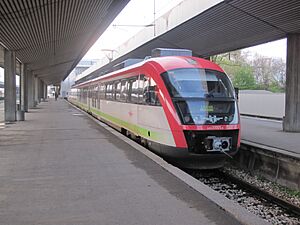
The Central Railway Station is the main place for train travel. It connects Sofia to other cities in Bulgaria and other countries. Sofia Airport handled over 7 million passengers in 2023.
Public transport is very good in Sofia. There are many bus, tram, and trolleybus lines. The Sofia Metro (subway) started in 1998 and now has four lines and 47 stations. It helps people get around the city quickly. The metro even goes to Sofia Airport and Business Park Sofia.
There are about 13,000 taxi cabs in the city. You can also use carsharing services with electric cars.
Many people in Sofia own cars, which has led to more traffic and air pollution. The city is working to improve its streets. Extending the metro system is hoped to help with traffic problems.
Sofia has a large district heating system. This means most homes get heat from central plants. This system uses energy efficiently.
Education and Science
Sofia has many schools and universities. There are 221 general schools and many specialized schools for arts or sports. The city also has 23 of Bulgaria's 51 universities. More than 105,000 students attend university in Sofia.
The American College of Sofia is a private high school with a long history. Many language schools teach in foreign languages like English, German, and Spanish.
The top universities include Sofia University, the Technical University of Sofia, and the Medical University of Sofia. Sofia University was founded in 1888 and has over 20,000 students.
Other important places for science are in Sofia, like the Bulgarian Academy of Sciences (BAS). BAS is the main center for scientific research in Bulgaria. It has many institutes and scientists. All five of Bulgaria's supercomputers are also in Sofia.
International Connections
Sister Cities
Sofia is connected with many cities around the world. These are called sister cities:
- Algiers, Algeria
- Amman, Jordan
- Ankara, Turkey
- Bucharest, Romania
- Doha, Qatar
- Kyiv, Ukraine
- Pittsburgh, United States
- Salalah, Oman
- Shanghai, China
- Sidon, Lebanon
- Tel Aviv, Israel
- Tbilisi, Georgia
Cooperation Agreements
Sofia also works closely with these cities:
Honors
Serdica Peak on Livingston Island in Antarctica is named after Serdica, Sofia's ancient name.
Media in Sofia
Public Media
- Bulgarian News Agency (since 1898)
- Bulgarian National Radio (since 1935)
- Bulgarian National Television (since 1959)
Private Media
- Nova Broadcasting Group (since 1994)
- bTV Media Group (since 2000)
Images for kids
See also
 In Spanish: Sofía para niños
In Spanish: Sofía para niños


